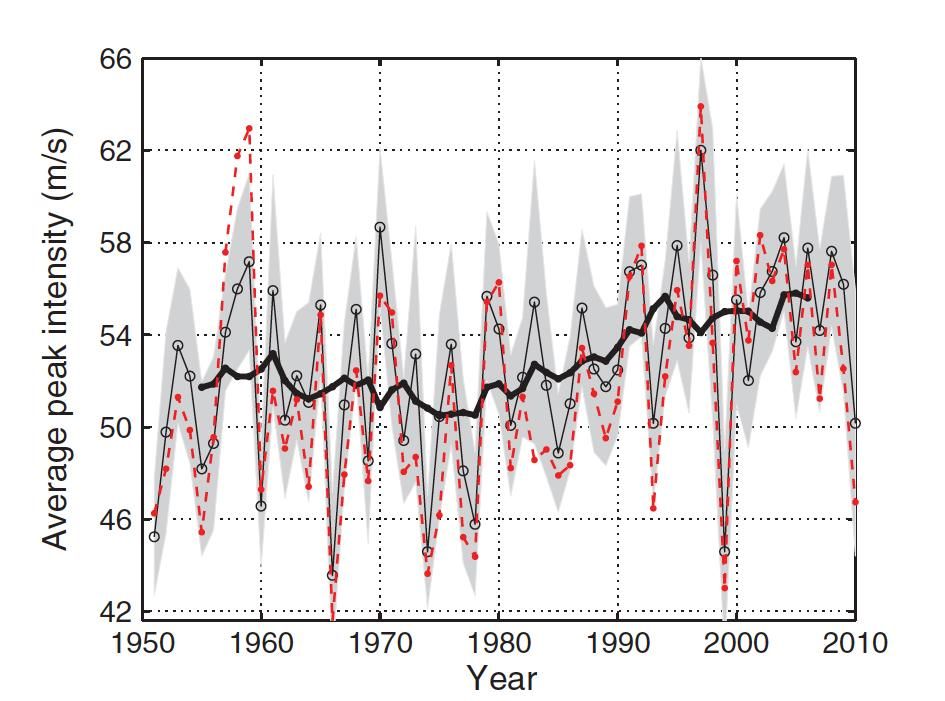Warmer Waters Are Making Pacific Typhoons Stronger
Decades of storm data show that tropical cyclones in the Pacific are getting more intense as ocean temperatures rise
/https://tf-cmsv2-smithsonianmag-media.s3.amazonaws.com/filer/1a/0f/1a0f885d-71d5-4501-b50e-d57c0ff02036/10825378203_54d758fd34_o.jpg)
Tropical cyclones in the northwestern Pacific have strengthened about 10 percent since the 1970s because of warming ocean temperatures, researchers report this week in Science Advances. According to an extensive analysis of historical cyclone data, nearly 65 percent of typhoons now reach category 3 or higher on the Saffir-Simpson scale, compared with around 45 percent just decades ago.
The northwestern Pacific produces some of the world’s most intense and most devastating tropical cyclones, called typhoons in the Pacific and hurricanes in the Atlantic. The category 5 super typhoon Haiyan, for instance, had record winds that reached nearly 200 miles per hour, and the 2013 storm killed at least 6,300 people in the Philippines.
“It is important to understand what controls typhoon intensity and to predict how it will change,” says lead study author Wei Mei of the Scripps Institute of Oceanography.
For years scientists have been working to determine how climate change is affecting these storms. Warmer waters should make for more intense storms in theory, but plenty of other factors can affect tropical cyclone development. This year’s Atlantic hurricane season, for instance, should be below normal in part because of El Niño, according to the most recent forecast from the National Oceanic and Atmospheric Administration. Such variability has made finding a signal from climate change difficult.
In the new study, Mei’s team looked at the average intensity of tropical cyclones that occurred in the northwestern Pacific between 1951 and 2010. They focused on storms that reached at least category 1 on the Saffir-Simpson scale and examined season-to-season variability, of which there was quite a bit. Some seasons saw much stronger storms on average than others, others much weaker. Plotted out over the years, though, the average intensity could be seen starting to rise in the 1970s.
But what is causing that rise? The team considered several factors that influence tropical cyclones, such as air pressure, sea surface temperatures and localized differences in wind speed and direction, known as wind shear. They were surprised to find that the variability in ocean temperatures, rather than atmospheric conditions, were dominant in controlling the observed changes in typhoon intensity, Mei says.

“How strongly and quickly a cyclone can grow depends on two oceanic factors: pre-storm sea surface temperature and the difference in temperature between the surface and subsurface,” Mei explains. “A warmer sea surface generally provides more energy for storm development and thus favors more intense typhoons. A large change in temperature from the surface to subsurface, however, can disrupt this flow of energy, because strong winds drive turbulence in the upper ocean, bringing cold water up from below and thereby cooling the sea surface.”
Since the mid-1970s, sea-surface temperatures in the tropical northwestern Pacific have risen by about 1 degree Fahrenheit, while temperatures at 250 feet below the surface have gone up by about 1.4 degrees. This reduction in the vertical temperature difference favors more intense typhoons, Mei says.
The researchers project that even under a scenario of moderate warming—one in which there are cutbacks in greenhouse gas emissions—the average typhoon intensity will still increase by another 14 percent by 2100. If emissions continue apace, “we anticipate that the typhoons will intensify even more,” Mei says.
There appears to be a trade-off between typhoon number and intensity. A recent study published in Nature Climate Change found that as ocean waters have warmed over the last 30 years, tropical cyclones globally have slightly decreased in number but increased in intensity. And earlier this year, a team led by Mei reported in the Journal of Climate that the number of storms in the northwestern Pacific has declined since the mid-1990s due to rising sea surface temperatures.
But the decline in storm number should not put anyone at ease, Mei notes: “It is the most intense typhoons that cause the most damage.”
/https://tf-cmsv2-smithsonianmag-media.s3.amazonaws.com/accounts/headshot/Sarah-Zielinski-240.jpg)
/https://tf-cmsv2-smithsonianmag-media.s3.amazonaws.com/accounts/headshot/Sarah-Zielinski-240.jpg)